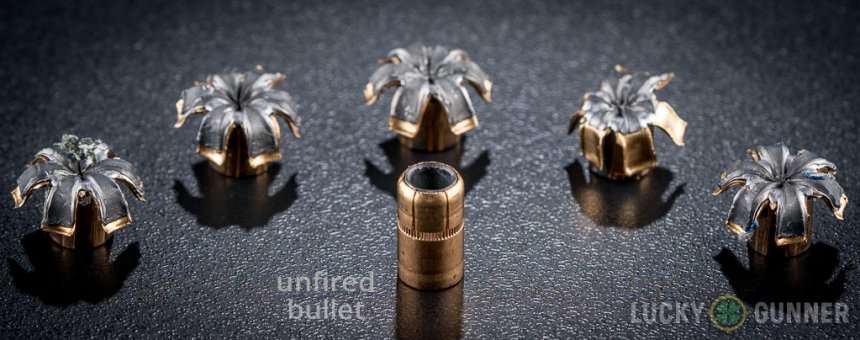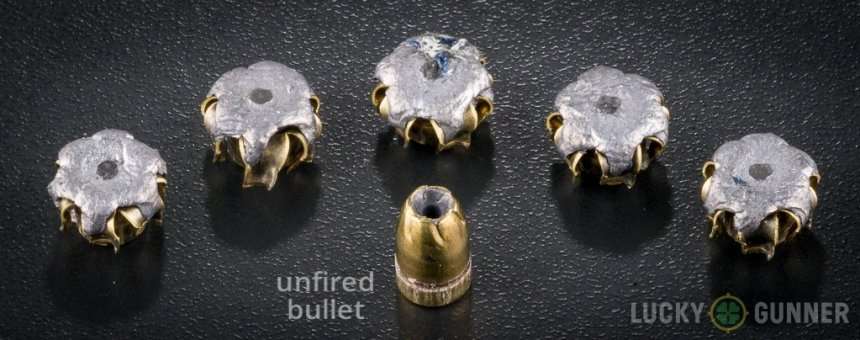
The 38 Special is one of the most popular handgun calibers for self-defense. At least part of the reason why is because it has been around for so many years and has really had the chance for wide adoption.
Another reason is because revolvers that shoot 357 Magnum will also be able to shoot the 38 Special. This makes it a great dual-purpose cartridge, and one that can be used in self-defense when the right ammo choice is made.
There are only a couple of choices for the best 38 Special ammo for self-defense, because of what the ammunition needs to do, and the fact that it usually falls short.
(I’m not talking about wadcutters, but jacketed hollow point ammo. I can dedicate another article to wadcutters at some point in the future.)
All self-defense ammunition needs to do a couple of things very well to be effective at stopping an attack.
First, the bullet needs to move fast enough to trigger its expansion. And, it needs to expand big enough on a consistent basis to do internal damage.
Second, it needs to travel deep enough to do the needed damage to the internal organs of your attacker.
38 Special lacks velocity when compared to other calibers, so the design of the bullet becomes even more relevant. Sadly, many of the bullets out there are not designed to expand consistently and may even get plugged up with clothing, preventing them from expanding.
This begs the question, then —
What is the best 38 Special ammo for self-defense?
- 130 Grain Federal HST Micro P+ (2 and 4-inch barrel)
- 125 Grain Remington Golden Saber +P (4-inch barrel)
- 130 Grain Winchester Train and Defend (4 inch barrel)
- 110 Grain Hornady Critical Defense FTX P+ (2-inch barrel)
How did I come up with that list? Well, first, let me state that we all stand on the shoulders of giants. And, in this case, I get a lot of my info from another source. The Lucky Gunner Labs have been a good source of ammo performance for many years.
I also have many years of experience under my own belt and have studied ballistics in depth. Hopefully, by perusing my blog you have found that out for yourself.
Finally, I’ve worked for the industry for many years, have owned this blog for almost five years, and was the managing editor of two big gun publications, and a staff writer for others.
I’m not new to this.
The requirements for inclusion:
The requirements are simple.
- First, the bullet needs to have consistent expansion. Studies have shown that when a bullet expands and has a bigger surface area, it creates more internal damage.
- The next requirement is that the bullet travel no less than 12 inches and no more than 18 inches as per the FBI ballistics tests. The reason why, is because a certain depth is needed to maximize damage to the attacker’s body, all while not passing completely through the attacker’s body to hit an innocent person.
- Finally, the bullet needs to stay together and retain most of its weight. Please note that I’m not talking about frangible ammo here, because there is a time and place for frangible ammo. I’m talking about ammo that breaks apart when it shouldn’t.
Before you move on, there is one more thing you should know, which is what +P ammo is. Essentially, it is ammo that has been loaded to higher pressures in order for the projectile to have more power or downrange velocity.
I go more into +P ammo, as well as if your gun can shoot it, in that article.
Let’s take a more in-depth look at each one:
Federal HST Micro +P

Without a doubt, if your gun can fire +P ammo, this is the 38 Special ammunition you should be carrying if you can find it. This ammunition works well in both snub-nosed revolvers, and those with longer barrels.
In fact, Federal designed it to work well in shorter barrels, and it expands beautifully and reaches proper depths on a regular basis as well.
Part of the reason why this ammo works so well is because of the bullet design. While it’s a jacketed hollow point bullet, it’s recessed back into the case like a wadcutter is. So, it sits flush.
The reason why this is good, is because it aids in expansion a lot more than the others, because of how much wider the hollow point is at the start. Whereas other hollow points come to a point, the HST Micro listed here is the same diameter from the base of the bullet to the opening of the hollow point.
It also works well because, even though it is a +P round that is loaded to higher pressures, there is virtually no overpenetration because the bullets expand very consistently and start to do so almost immediately after hitting the target.
They work well in snubby and revolvers with longer barrels, but they penetrate deeper from a four-inch barrel with an average depth of 14.1″ after five shots. Average bullet diameter from those same five shots was .71 inches, or roughly double in size from the original .357.
Remington Golden Saber +P

Coming in at a distant second and working better when fired from four inch barrels unless you want to take a chance on the bullet not reaching the desired depth, is the 125 Grain Remington Golden Saber +P 38 Special rounds.
They will work decent in a two inch barrel, but I wouldn’t use them in my snub nose revolver and would never recommend you do something that I wouldn’t do.
The Golden Saber line is a proven self-defense round for many different calibers like I show you in the best 45 ACP ammo for self-defense in that article so it’s no surprise that it’s also on this list.
When fired from a revolver with a four-inch barrel, the Golden Saber rounds reach an average depth of 12.5 inches across the five shots. That depth is just barely in the green zone, but all five shots make it to the 12-inch mark, which is what is necessary.
And, in the LG Lab test, the rounds expanded to an average of .59″ across the five shots. Those are not the best results, but they are consistent which is more than half of the battle.
Winchester Train and Defend

The Winchester Train and Defend is actually a solid performer, especially when you consider that it’s the only round on this list that isn’t a +P load. I had to include at least one for those of you who don’t feel confident in shooting a higher pressure load in your revolver.
This one also works better with the four-inch barrel than in a snub nosed revolver like mine, because they don’t consistently expand when fired from a shorter barrel.
Out of the four-inch barrel the 130 grain Train and Defend from Winchester reaches an average depth of 14.1 inches, which is certainly respectable. And the average diameter of the rounds when fired reached an average size of .59 inches.
Hornady Critical Defense +P

Finally, we get to the Hornady Critical Defense rounds, which are the ones I had on hand to take a picture of. Hey, what can I say ammo price and scarcity have my ammo supply at all-time lows.
Before I forget, I do want to say that the non +P version of this ammo works okay, too. I didn’t list it above because I intended to include it here. Just know that it doesn’t expand as consistently as its +P variant under the conditions LG Labs tested it in.
What I mean by that, is that I find it unrealistic to test with four layers of clothing, and believe that this round would perform better with fewer layers of clothing. For example, I personally don’t wear four shirts and don’t know many people who do.
Maybe in the winter there might be two shirts, and maybe a jacket, but that still isn’t four layers of clothing, and most folks also don’t wear jean jackets anymore.
These really work better in the short 2″ barrels. I suspect that the reason why is because the bullet reaches a faster velocity in the longer barrel (over 100 FPS faster) and expands much bigger, much faster. And because it does the bullet stops way too early.
The five shots of +P reached an average depth of 13″ and expanded to an average of .46. The reason why these are last on the list is because those are not the best numbers. There is still expansion but it’s not very good.
The issue with 38 Special for self-defense:
This is the point in the article where I know I’m about to piss someone off. It can’t be avoided and I have to tell the truth. That truth is this: Traditional 38 Special is really insufficient for self-defense.
That is one of the reasons why there is only one non +P variant listed, even though the Hornady Critical Defense line performs okay with the non +P version. It is, however, just okay.
Part of the problem with 38 Special is a lack of velocity that isn’t seen in the best 357 Magnum self-defense rounds.
It lacks the needed velocity to trigger the expansion needed to do internal damage or has a bullet design that doesn’t facilitate proper expansion and passes right through the body. Another issue comes about when the bullet stops too short of the needed depth to do any real damage.
Because of this, there are only a handful of good loads for 38 Special, and those are the ones listed.
Having said that, there are some good loads that have come out recently that we haven’t had a chance to examine yet due to the ammo shortage and the price of ammo being so high. One of those loads is the Federal Hydra-SHOK Deep.
That bullet has shown tremendous promise, and there are others, as well, and I plan to test it at some point in the near future.
Make sure you check out our big pistol ballistics chart, next.

